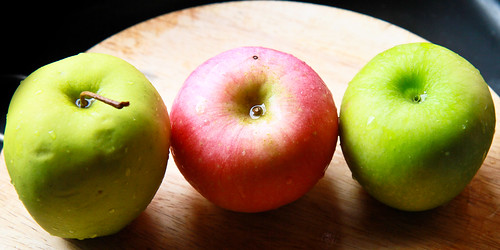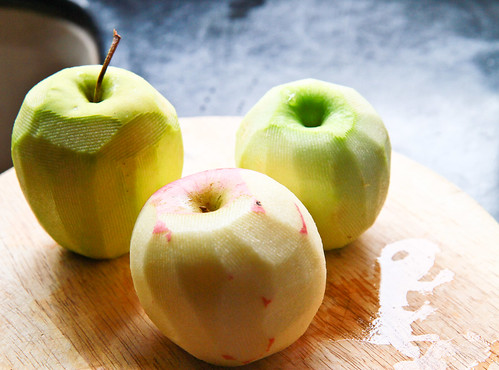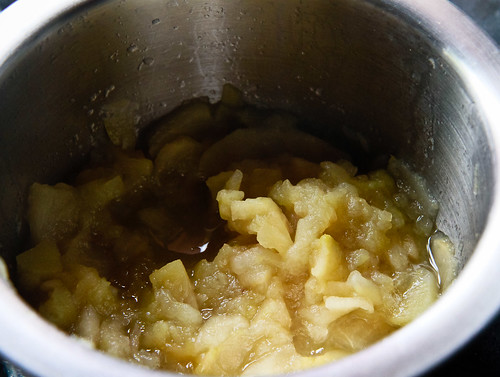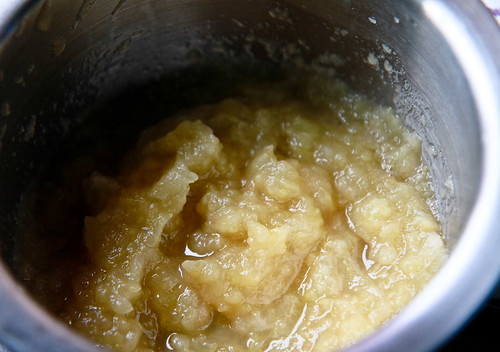For a while during my december holidays, I toyed with the idea of going on a low-carb diet. But as with most of my ideas, it went down the drain when I realized that I had to forgo a few of my most favorite foods - bread, pastries and cakes! So I embarked on trying to substitute one of my meals with a high protein, low carb alternative and looked towards healthier alternatives for my baking. One of the things that popped up the most was the substitution of applesauce for any oil in a recipe. I saw this substitution a lot when I was looking at muffin recipes, but it can be used in other types of bakes as well.
Since then, I bookmarked recipes for making applesauce but did not try it because I was attempting other more interesting recipes. It was only when I was reading Nick Malgieri's book and was entertaining a craving for oatmeal cookies that I decided to finally to try out making my own applesauce.
For the uninitiated, why can we substitute applesauce for oils in a recipe?
Fats add richness and texture. The primary function of fats in a recipe is to coat the proteins in the flour, thereby preventing them from mixing with the liquid ingredients and forming gluten, which would result in a tough texture. Applesauce is good substitute, because it is high in pectin, and pectin can also coat the protein, inhibiting the development of gluten and thus keeping the baked good tender and moist. However, applesauce has water, which is a liquid which can contribute to gluten formation. Also, applesauce is more moist than oil, which might result in a more liquid batter. One method to avoid gluten formation is to mix the liquid ingredients and sugar first, and the other dry ingredients separately before combining them together gently and as little as possible. This is because gluten begins to form as soon as flour comes into contact with a liquid and gets more active with stirring.
General rules of thumb
- Tenderness, moisture and flavor changes when substitutions are made. Because of its moistness, applesauce substitutions work best for cakey recipes - this includes cakes, muffins, brownies, quickbreads, chewy cookies.
- Oils in a recipe can include butter, or canola oil or shortening. Any butterfat in a recipe can be substituted. Generally, 1 cup of oil can be substituted with 1 cup of unsweetened applesauce. It is generally recommended to first substitute half of the oil in the recipe with applesauce, and slowly increasing the ratio until you are satisfied with the result. You can completely substitute the oil, but 1 to 2 tablespoons of oil in a recipe is ideal, as it will enhance the recipe's flavour. Note that by substituting half a cup of oil with applesauce, you are already reducing calories in the recipe by 1600 calories!
- If your applesauce is sweetened, reduce sugar in the recipe accordingly.
- You can also use other types of purees: pears, plums, pumpkin, banana or squash as substitutes.
- Since applesauce is acidic, add about 1/4 teaspoon of baking soda to smooth its flavour.
- Note that applesauce substitutions will result in a moister and softer texture, and is NOT suitable if you want a crisp texture (crispy cookies, for example).
- Do not overmix or overbake the cookies because low-fat batters tend to be dry and are prone to becoming tough and dense if overbaked. To prevent this, reduce oven temperatures by about 5°C and check the product for doneness a few minutes before the end of the usual baking time.
Applesauce
IngredientsAdapted from Nick Malgieri's Perfect Light Desserts
3 apples (I used a mixture of Delicious, Fuji and Granny Smith)
30 ml water
For a more flavorful applesauce, add up to 30g of sugar or 1 tsp of lemon juice or a dash of ground cinnamon or all of the three.
Method:
- Peel, halve core and chop apples.
- Place them in a medium saucepan with the water and cook over medium heat until the mixture comes to a boil.
- Lower the heat and allow the apples to simmer in their juices for about 20 minutes, stirring occasionally so that the apples do not scorch.
- If the apples become very dry before they have disintegrated, add 2 to 3 tablespoons of water and continue cooking until the apples turn into a chunky puree.
- Use a whisk or potato masher to break up any large chunks. You can also use the back of your fork or spoon to do the same.
- Remove from heat and let applesauce cool before using it.
 |
| Golden Delicious, Fuji Apple, Granny Smith (From L-R) |
 |
| Peel, halve and core the apples. Chop them into tiny pieces. |
 |
| Add 30 ml of water to the apples and bring it to a boil before allowing it to simmer. |
 |
| The result after a 30 minute simmer - if you are fine with this texture, then there is no need to mash it up! |
Janine's Jots:
- This recipe is for unsweetened applesauce - you can add up to 1/4 cup (~50g) white or brown sugar if you want a sweetened version. Unsweetened applesauce is somewhat of a misnomer because it has the sweetness of the apples - you can smell it while it's cooking! Don't follow any recipes strictly, instead, slowly add sugar to the mixture and taste it until the sweetness suits your preference
- You can also cook this in your slow cooker if you like - about 2-3 hours will give you the same result.
- For a more complex version, check out Elise's recipe here.
- I mixed the types of apples I used to increase the complexity of taste in the applesauce. Using the same type of apples is fine.
Comments: I'll update with Nick's oatmeal recipe as soon as I try it out! Right now I'm having fun eating the applesauce and using it in my apple pies as extra filling :)

No comments:
Post a Comment